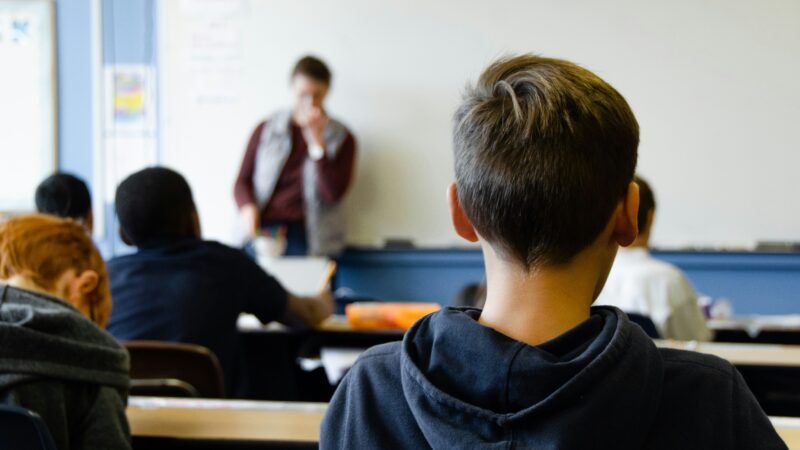More Evidence That COVID School Closures Wrecked Student Performance
California's poorly served public school students need more than a few more dollars diverted to tutoring programs. They need an escape hatch.

When COVID-19 shuttered virtually everything in 2020 and forced public schools to begin distance learning, those schools responded with the agility one would expect from a decrepit battleship forced to make a quick change of course in the face of an unexpected enemy. In other words, the state's hulking K-12 system barely responded at all, even as small and nimble private and charter schools quickly adapted to the new reality.
I remember news stories about public schools unable to set up even the most basic Zoom classes, of teachers who had no idea what they were supposed to do—and then of unions and administrators resisting efforts to re-start classroom teaching even after the rest of society was getting back to normal. Instead of re-ordering procedures to help kids stay current on their schoolwork, the school establishment mainly whined about not having enough money.
Anyone who needs a reminder about why government bureaucracies are incapable of providing quality public services need only look at the resulting disaster. A Stanford University study found, "a substantial decline in student learning in both English language arts/literacy (ELA) and mathematics between the 2018–19 and 2021–22 academic years." Those are the general figures, but the results for poor and minority students were a travesty.
California's lowest-income students already fared second to last in the nation in 2018, before anyone had even heard of coronavirus. After the pandemic closures, the study found that only 16 percent of Black students met or exceeded state math standards—a number that was below 10 percent for English learners. And then there are the appalling truancy numbers: Nearly a third of the state's K-12 students were chronically absent during the ruckus.
We heard rumblings of a "parent revolt," which manifested itself in some high-profile school board elections. But, again, it's hard to turn around a giant ship—especially one that for years has been taking in water. In the private sector, unhappy customers take their business elsewhere. With government agencies, the process for making change is daunting. Booting bad school board members is a start, but there are so many obstacles to improving matters at the classroom level.
A recent settlement has been touted as a way to force the state to enact meaningful reforms that might improve achievement after several parents had filed a lawsuit against the state. "The change in the delivery of education left many already-underserved students functionally unable to attend school," they noted in their complaint. "The state continues to refuse to step up and meet its constitutional obligation to ensure basic educational equality or indeed any education at all."
The agreement earmarks $2 billion in remaining COVID funds to pay for tutoring, counseling, and after-school activities, CalMatters reported. I applaud the agreement, but have limited expectations. Mainly, as the publication noted, "the case has drawn attention to the magnitude of the learning loss during the pandemic." How much more drawing attention do we need? And more than 40 percent of the state budget goes to K-14 education, so a little more money won't institute the change we need.
I also take issue with CalMatter's description of the "herculean efforts by school staff to keep students engaged." I'm sure many teachers and administrators tried their best, but Hercules succeeded at completing his nearly impossible 12 labors—and most public schools failed to complete even the most elementary educational tasks.
Meanwhile, Gov. Gavin Newsom and the Democratic-dominated Legislature have been taking aim at one reform that has enabled many ill-served students get a quality education. At the behest of teachers' unions, they restricted the growth of charter schools. Empowered by the new laws, Los Angeles Unified School District this month "passed a sweeping policy that will limit when charters can operate on district-owned campuses," the Los Angeles Times reported.
That above-mentioned Stanford study noted that dismal test scores "should sound a loudly screaming alarm: The task of transforming our schools can no longer be delayed." Yet warning sirens have been sounding for years and the public-school establishment continues in the wrong union-dictated direction.
The latest lawsuit echoes the Vergara decision, a 2014 Los Angeles case that initially tossed teacher-employment protections including tenure. The court found that these firing restrictions leave "grossly ineffective teachers" in the classroom. The impact, which disproportionately harms lower-income students, "shocks the conscience," it added. Higher courts eventually overturned the ruling. The state didn't heed the alarm bells. They mainly energized teachers' unions, which feared the impact on their protected employment.
So here we are again. How much more evidence do we need? California's poorly served public school students need more than a few more dollars diverted to tutoring programs. We need to airlift them off a sinking ship and into competitive educational vessels. Quite frankly, with the money the state spends on education, every student could have a room on a luxury cruise liner.
This column was first published in The Orange County Register.



Show Comments (54)